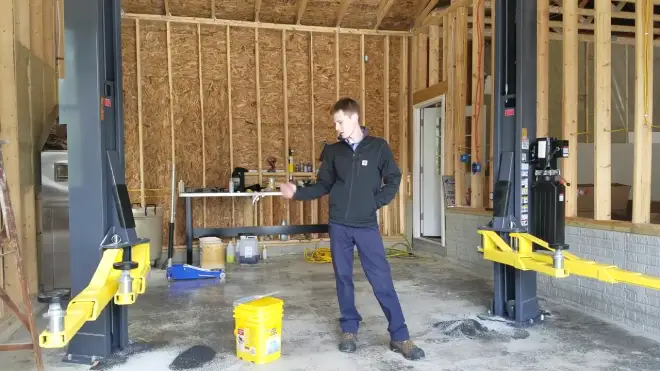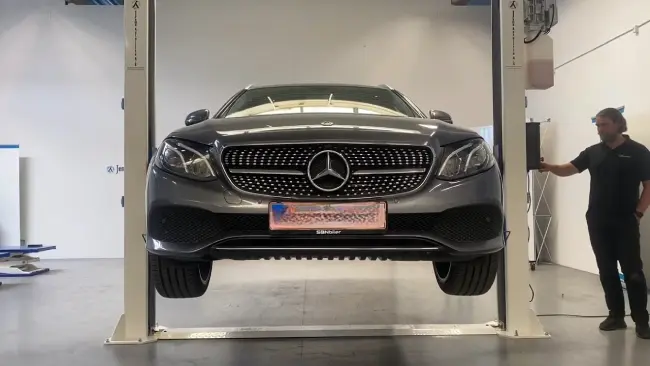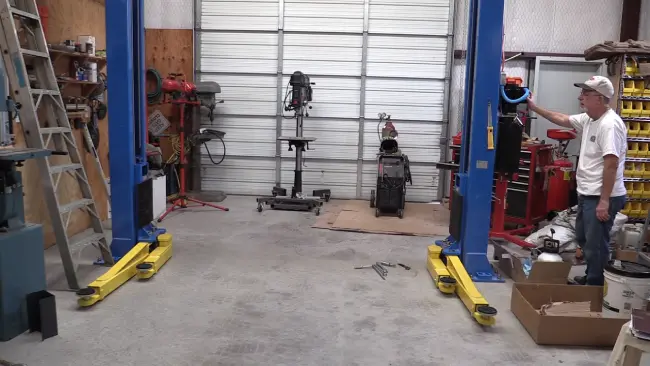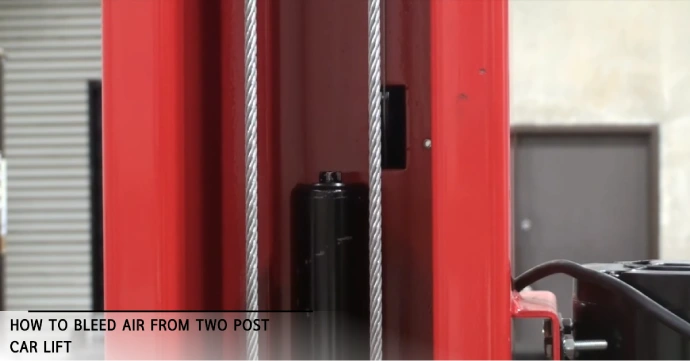Last Updated on June 14, 2023
If you work with cars and have a two-post car lift, you know that air in the hydraulic lines can cause a huge problem. It can stop the lift from working or even fail completely, which can be dangerous. But bleeding air from your two-post car lift is an easy procedure you can do yourself.
You must fill the power unit with proper fluid to bleed air from a two-post car lift. Afterward, raise the lift and locate the cylinder opposite the power unit. Now use a wrench to open the bleeder to release air and then tighten the air stops. You may need to repeat these steps if the air’s still in the line.
Today we will guide you through the step-by-step process of bleeding air from a two-post car lift. We will explain the symptoms of air in the hydraulic system, why you need to bleed air out, and what can happen if you don’t.
How to Bleed Air From Two Post Car Lift: Step-By-Step Procedures

Step 1: Fill the Power Unit With Hydraulic Fluid
Step 2: Raise the Lift Off the Ground
Step 3: Locate Cylinder Opposite Power Unit
Step 4: Open Bleeder to Release Air
Step 5: Tighten Bleeder When Air Stops
Step 6: Repeat the Process on the Cylinder with Power Unit
Step 7: Test the Lift by Running it Up and Down
If you want to learn how to bleed air from a two-post car lift, follow these step-by-step procedures.
Step 1: Fill the Power Unit With Hydraulic Fluid
Before you can use your lift, you’ll need to fill the power unit with the right hydraulic fluid. The hydraulic fluid needed for your 2-Post lift is Dexron III ATF, which meets ISO 32 specifications.
Use the correct fluid type to ensure the lift operates properly and to avoid any damage to the lift or the vehicles being lifted. Locate the fill plug on the power unit to fill the power unit with proper hydraulic fluid.
Remove the plug and fill the power unit with the appropriate fluid until it reaches the recommended level. Once the power unit is filled, replace the fill plug.
Step 2: Raise the Car Lift Off the Ground
Now raise the lift above the ground just below the first lock. This is crucial to bleed air from your two-post lifts. Ensure the lift pads are positioned under the vehicle’s jacking points. Once the lift is properly raised, it’s time to move on to the next step.
As the lift is raised off the ground, the hydraulic fluid can circulate throughout the system, pushing any trapped air toward the top. This is why ensure the lift is just below the first lock. If it’s too high, the air will remain trapped in the system and will not be effectively bled out.
Step 3: Locate Cylinder Opposite Power Unit
Now it’s time to find the cylinder on the column facing the power unit, like a hidden treasure waiting to be discovered. You’ll work with this cylinder to bleed the air from your two post car lifts.
Locate this cylinder before moving on to the next step, as it’ll save you time and frustration later on. The cylinder is typically located on the opposite side of the power unit and is easily identifiable by its cylindrical shape.
Step 4: Open Bleeder to Release Air
Let’s start by using a wrench on the cylinder’s bleeder screw and opening it slowly to release any trapped air. Air should be bled from a two-post car lift hydraulic system, as air bubbles can cause the lift to operate improperly or even fail completely.
As you open the bleeder screw, you should hear a hissing sound as the air is released. Keep the wrench in place and continue to open the bleeder screw until you see fluid flowing steadily from the cylinder.
Step 5: Tighten Bleeder When Air Stops
As you release the trapped air from the system, tighten the bleeder once the air stops coming out. This ensures that the air is completely removed from the system and the lift is ready for use.
Once you’ve tightened the bleeder, double-check to ensure it’s not loose. A loose bleeder can cause air to enter the system, leading to safety issues and equipment malfunction.
Step 6: Repeat the Process on the Cylinder with Power Unit
If the air is still left, grab your wrench and position yourself near the bleeder screw. Loosen it just enough to release the air inside, but be careful not to unscrew it completely. You want to avoid creating a bigger mess by spilling hydraulic fluid everywhere.
As you loosen the bleeder screw, you’ll notice air bubbles escaping. Keep an eye on the hydraulic fluid level in the reservoir and add more if necessary.
Step 7: Test the Lift by Running it Up and Down
Now thoroughly test the car lift by running it upwards and downwards a few times to ensure it operates smoothly and safely. Here are some steps you can take to test your lift:
- First, ensure the lift is properly secured and no obstructions are in the way.
- Next, raise the lift and lower it slowly, paying close attention to any unusual noises or movements.
- Repeat these steps a few times to ensure the lift is operating smoothly and there aren’t any issues.
What are the symptoms of air in the two-post car lift hydraulic system?

Air in the hydraulic system of a two-post car lift can compromise its performance and functionality. It can cause a range of symptoms that can affect lifting and lowering actions, which can compromise the safety and efficiency of the lift.
You may experience some issues that may indicate that there is air in your two-post car lift hydraulic system when there is air in it:
#1 Soft or Spongy Lift Operation
When the air gets into the hydraulic lines of a two-post car lift, it can affect the lift’s operation. One of the significant symptoms of air in the system is when the lift feels soft or spongy during operation.
The lift’s hydraulic pressure will be reduced, lacking the usual firmness and responsiveness, making the overall operation less efficient. It can lead to difficulties working on the car and make maintaining a safe working environment difficult.
#2 Inconsistent lifting or lowering:
Air bubbles in your hydraulic system can cause erratic and inconsistent lifting and lowering of the vehicle. This symptom can appear in different ways, such as jerking motions, uneven movements, or the lift may fail to rise smoothly.
These symptoms can be dangerous to the operator and the vehicle being lifted. It can cause the car to become unstable, potentially leading to accidents during maintenance.
#3 Insufficient Lifting Capacity
Air pockets in the hydraulic system can reduce the pressure, resulting in insufficient lifting capacity. Heavy loads may be difficult or impossible to lift, and the lift may need help to reach the desired height.
This can not only lead to difficulties and delays, but it can also pose a severe risk to personnel and equipment.
#4 Noises or Vibrations
If you hear unusual sounds from your two-post car lift, it could indicate air in the hydraulic lines. These noises may include hissing, gurgling, or popping sounds.
The presence of air in the system can cause vibrations during lift operation, leading to poor performance and even damage to the lift. Be sure to check for any unusual noises and address the issue promptly.
#5 Delayed or Sluggish Lift Response
The air in your hydraulic lines could be causing your lift to take longer to start lifting or lowering. Slow or delayed lift response can be frustrating and time-consuming, slowing maintenance tasks and decreasing profitability.
#6 Inconsistent locking mechanism
A properly functioning locking mechanism is essential for your lift’s safety. But air entering the hydraulic system can affect the locking mechanism and cause it to engage or disengage improperly.
This means that the lift may fail to lock securely in position or unexpectedly disengage, posing a safety risk. To ensure your lift’s locking mechanism works correctly, have it regularly inspected by a qualified technician.
How can air enter two post-car lift hydraulic lines?

Like a straw that won’t work if air gets in the way, your two post car lift won’t work properly if air is blocking it. Bleeding air out of your car lift hydraulic lines is essential to ensure your lift works smoothly and safely.
Air can enter the hydraulic system in several ways, such as:
- when the fluid level drops too low,
- when a hydraulic line is disconnected, or
- when the system is opened for maintenance.
The air can compress, leading to a spongy feel in the lift or causing it not to lock in place correctly. Also, air can cause the hydraulic fluid to oxidize, leading to corrosion and damage to the lift’s components.
How often should I bleed air from my two-post car lift?
It’s crucial to regularly bleed air from the two-post car lift to ensure optimal performance and longevity. Generally, the frequency of air bleeding varies depending on the lift’s usage.
Check the lift’s user manual or contact the manufacturer for guidance on maintenance intervals. Moreover, neglecting to bleed air from your lift can lead to air pockets, interfere with hydraulic operations and cause equipment damage.
Are there any precautions I should take while bleeding air from the lift?
Safety precautions are paramount when bleeding air from your two-post car lift. Before attempting to bleed air, ensure that the lift is properly secured
Also, you may use appropriate personal protective equipment (PPE) as you work with hydraulic components. The PPE may include gloves, safety goggles, and specialized footwear for ultimate protection.
Can I bleed air from my two-post car lift, or should I call a pro?

Although it’s possible to bleed air from your two-post car lift by yourself, it requires sufficient knowledge of the process. If you need more expertise or experience and are uncertain about bleeding air, it’s best to seek professional assistance.
Working with hydraulic equipment can be dangerous, and one incorrect step can lead to equipment damage or severe injury. A qualified technician can provide the necessary guidance on air bleeding procedures, ensuring that you avoid any potential hazards.
Avoid Hydraulic Failures: Release the Stuck Air in the System
If you want to avoid damaging your car and lift with air bubbles in the hydraulic system, follow the above step-by-step procedures. Not only will you save yourself the hassle of a malfunctioning lift, but you’ll also prove your mechanical prowess.
When working with heavy machinery, safety should always be your top priority. Take the time to bleed the air out of your hydraulic lines properly. You may need to repeat this process until all the air is removed from the system.
Once you have finished bleeding the system, check the hydraulic fluid level and top it up if necessary. You can confidently lift and work on your car with a properly functioning hydraulic system.

